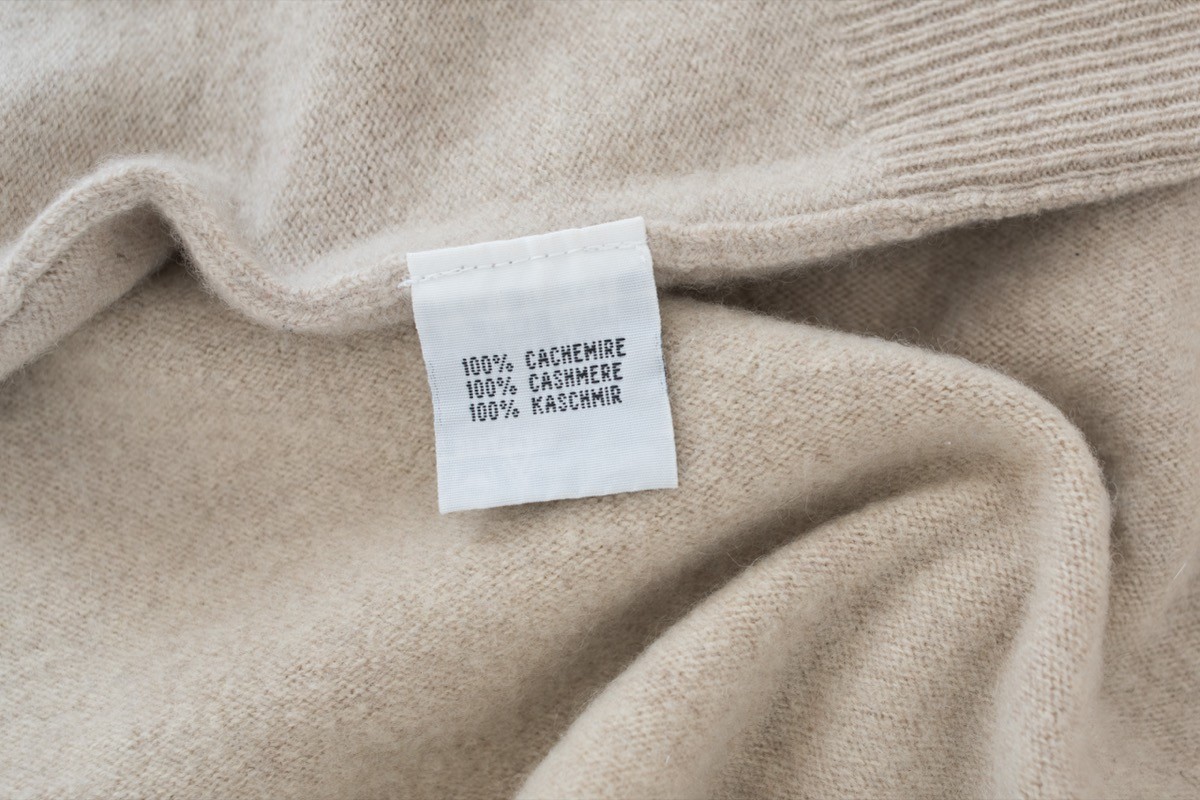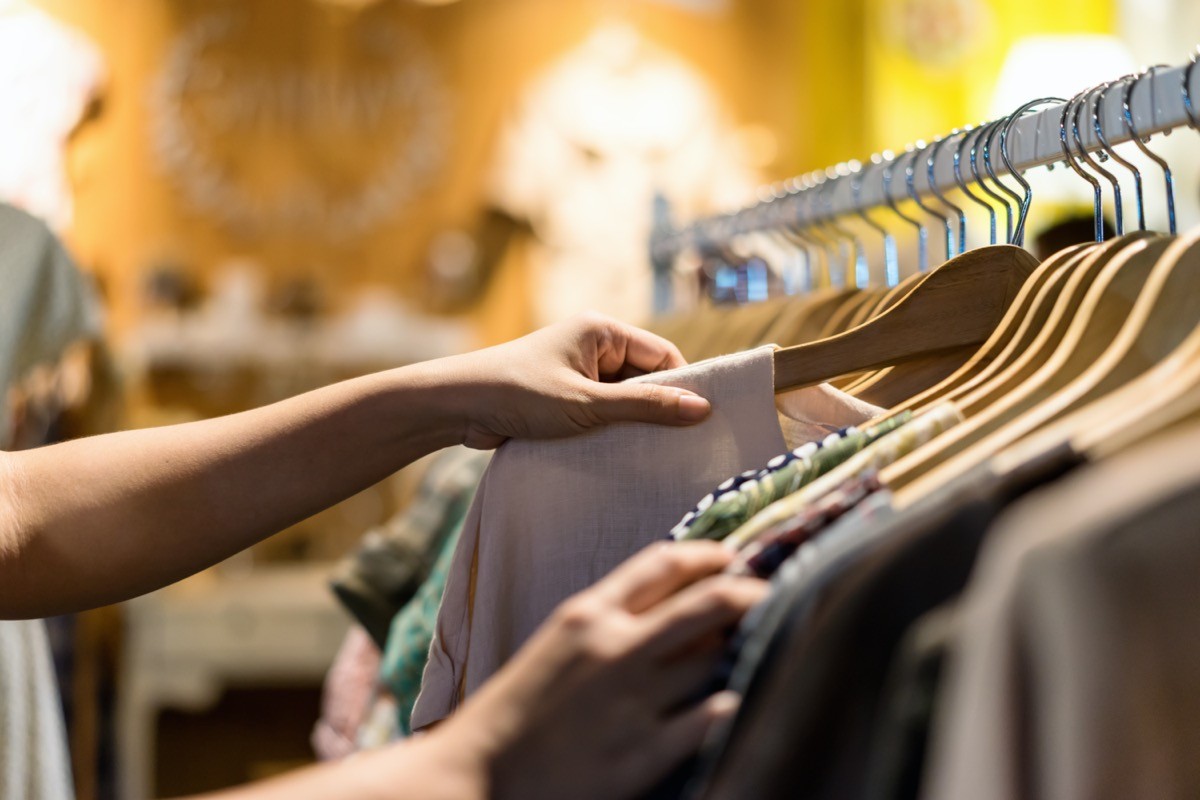8 Ways to Find the Best Thrift Store Treasures, Shopping Experts Say

Do you have that friend who’s always wearing cool retro outfits, whether it’s flare jeans from the 70s that just made a comeback (thanks, Kendrick!) or secondhand Chanel heels? Or maybe you know someone whose entire home is furnished with vintage finds like a reupholstered Chesterfield sofa or a rare Stickley hutch. I, for one, usually admire these people from afar, accepting that I just don’t have that special touch to uncover and style these treasures. But according to shopping experts, we can all become expert thrifters with a few insider secrets. Ahead, the pros share the best ways to find hidden gems at thrift stores.
RELATED: 5 Warnings to Shoppers From Ex-Goodwill Employees.
1
With home decor, look for the shape, not the color.

Candese and Kelly, two Pennsylvania-based best friends who run the uber-popular thrifting and design brand Crafted Hive Culture, recently took to TikTok to share their top “rules” for thrifting.
First on their list is to look for the shape of an item, not the color, when it comes to home decor.
For example, the video shares how they came across a white ceramic swan at Goodwill. It was faded looking and not very stylish, but after a full coat of gold paint, it made a chic addition to a kitchen shelf filled with white crockery and gold accessories.
“Once I stopped passing over things just because they looked a little rough or outdated, I started finding some of my best pieces,” they shared in the comments.
2
Ignore category and focus on function.

Next, Candese and Kelly advise thrift store shoppers to “stop seeing the items for the category they’re in, but more look for the function they can have.”
In this case, they spotted an old wooden checkerboard for $3 in the toy aisle at Goodwill. At home, they leaned it on that same kitchen shelf as a country-style cutting board.
RELATED: 7 Vintage Kitchen Items That Could Make You Rich, Experts Say.
3
Read clothing labels carefully.

Thrifting influencer @hannahhopecollective has some advice for finding the best fashion deals.
In a TikTok video, she suggests hunting for clothing made of “natural fibers” like cashmere, wool, silk, jute, linen, and cotton. Not only do these fabrics last longer and look more expensive, but Hannah says this approach leads her to find more “vintage” items, those 20 or more years old.
For shoes and accessories, look for leather and suede.
4
Go for neutral and classic clothing pieces.

Of course, don’t pass up that funky orange sweater if it brings you joy, but as a general rule of thumb, Hannah recommends sticking to neutrals and earth tones, as well as classic silhouettes.
This helps to build out a capsule wardrobe and makes it more likely you’ll stumble upon quality pieces from high-end brands.
RELATED: 6 Best Clothing Items to Buy at Thrift Stores, Stylists Say.
5
Don’t rule out slightly damaged clothing.

Love a blazer with a couple of missing buttons? Or maybe a pair of vintage Levi’s with a jammed zipper? Don’t rule these pieces out.
“You can purchase pieces that need repair if you know what repairs cost,” says Vivian Kelly, vintage clothing and fashion expert. However, she recommends first locating a reputable tailor where you know you can get these repairs done for an affordable price.
Sometimes, however, things are past their prime. “If an item is simply too worn out, it may be best to just pass on it,” Kelly adds. “Clothing does indeed have a shelf life.”
6
Take a trip out of town.

Thrift stores in more rural areas may be your best bet. Hannah shares that she gets most of her items from Salvation Army and Goodwill stores in the country area where she lives.
Deepak Tailor, founder and CEO of the website Latest Free Stuff, agrees that small-town thrift stores are the best for finding “one-of-a-kind” pieces: “Secondhand stores in larger cities, and big brand name shops, tend to be very overpriced, and they don’t have as many unique items.”
RELATED: 5 Vintage Clothing Items That Can Make You Rich.
7
Be strategic about when you shop.

It’s not just about where you shop but when you arrive at the thrift store.
“Although most thrift stores add new items throughout the day, heading there first thing in the morning means that things are more organized, and you’ll be the first to see if anything new has been put out on the floor,” says Jennifer Prince, owner and merchandiser at It’s Found Vintage.
It can also pay to visit a store regularly to get a feel for their prime shopping times.
“The more often you go, the more you learn when they bring out new merchandise, what their sale days are—and in some cases, which days they don’t restock,” says Willow Wright, owner of Urban Redeux in Alexandria, Virginia. “For example, a local store near me doesn’t restock on Mondays because everything is 25 percent off on Tuesdays.”
Brenda Christensen, CEO of Stellar Public Relations and former owner of Los Angeles vintage clothing store Vintage Diva, shares that seasonality matters, too.
“The best time of the year to go thrifting is post-holiday in January,” she notes. “People have gotten new items for Christmas or Hanukkah and are getting rid of things they don’t want that are brand new or replacing items.”
“Spring is another great time when people are hauling their unwanted items to the thrift store during spring cleaning rituals,” she adds. “And surprisingly, late fall is also good, as back-to-school prompts many to get a fresh wardrobe and declutter before the holidays.”
8
Do your research in real time.

Most of us don’t leave home without our smartphones, and you’ll want to make extra sure you have yours when you’re thrift shopping
“You can easily look up items you might think are valuable and see what they go for online,” Tailor advises. You’ll then have a better idea if it’s a good deal, regardless of whether you keep the item for yourself or resell it.